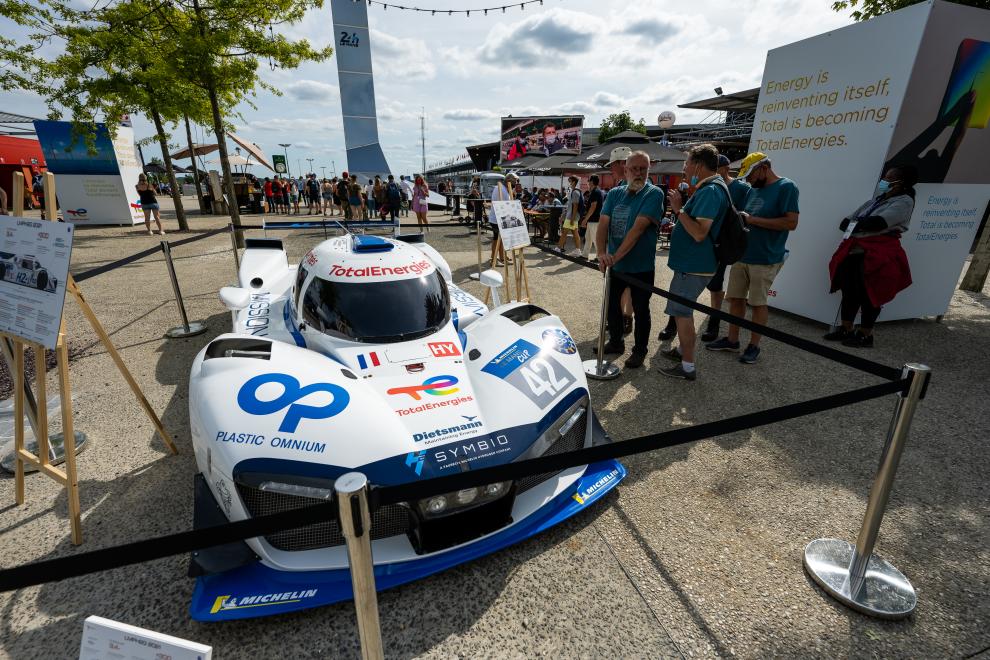H24: Mission Possible
An original luxury safety car was in action during the virtual 24 Hours of Le Mans in June 2020: the LMPH2G. Based on the LMP3 ADESS chassis, its internals have nothing to do with the V8 Nissan powering the prototypes of this category. A new type of car powered by electricity, its heart is actually a fuel cell. A true rolling laboratory developed as part of the Mission H24 project, the LMPH2G heralds the future of endurance racing.
The revolution is underway
Skillfully replacing the use of high-capacity batteries, the fuel cell allows to create electricity from dihydrogen stored in three high-pressure tanks. Refilling of the latter, containing 8kg of dihydrogen, is done in 3 minutes. The fuel cell is made up of several “stacks”: four in the case of the LMPH2G. It weighs 133kg and provides the energy needed to power the four electric motors, two per rear wheel.
In such a configuration, the LMPH2G has nothing to be ashamed of in terms of performance compared to its thermal counterparts since it develops 400hp (up to 650hp occasionally using energy recovery during braking), is capable of covering 400 meters in 11 seconds and reaching 100km/h in 3.4 seconds. All this without emitting any greenhouse gases, the only element being emitted is water: 1.2L/km of which part is reused to optimize the operation of the fuel cell.

A dizzying progression curve
If Mission H24 was born in September 2018, during the first rolling of the LMPH2G developed by Green GT, the company is no stranger to this task. Indeed, after the first prototype of this line, which was a cart equipped with a battery and electric motors, in 2012 an actual UFO followed the Green GT H2: a large prototype equipped for the first time with a fuel cell. The latter weighed 1850kg while the LMPH2G only weighs 1420kg.
While participation in the 2013 Le Mans 24 Hours as part of the 56th stand was considered at one point, the Green GT H2 primarily laid the groundwork for what appears to be a future project. The significant technological leap made between the three generations of prototypes attracted renowned drivers to join the adventure and help the technical team guide future developments. After Olivier Panis took the wheel of the Green GT H2 in 2016, followed by Olivier Lombard, it is now Norman Nato, Stoffel Vandoorne, and Stéphane Richelmi who take turns behind the wheel of the Swiss entity’s prototypes: the LMPH2G and the H24.

Hydrogen soon at the 24 Hours of Le Mans
The objective of Mission H24, carried out jointly by Green GT and the ACO, is to create a new category reserved for cars with this type of propulsion by 2025, a deadline pushed back by a year due to the constraints imposed by the health crisis. It must be said that the prospects are more than encouraging for hydrogen prototypes: for example, a fuel cell weighing less than 100kg is announced in 2 years compared to 133kg today, and only 1 tank instead of 3 currently, thus significantly reducing the mass.
This new category will be open to all manufacturers but a certain number of components will be shared by all cars.
- Tanks will be supplied by Plastic Omnium.
- The powertrain group (power electronics, gearbox, electric motors, …) will, unsurprisingly, be manufactured by Green GT.
- The chassis, for its part, will be produced by a joint venture between Red Bull Advanced Technologies and Oreca.
By standardizing all these components, the legislator’s stated intention is to control costs and of course to ensure that the winner of the category is the manufacturer who has done the best work around the fuel cell and its cooling system.
Even if the shells will be common and specific to this new category, the cars will be clearly identifiable since the aerodynamics of the upper part of the bodies will be specific to each manufacturer who can develop it according to their wishes, within the limits of the regulations of course. However, the lower aerodynamic elements of the car will be standard.
The unprecedented partnership between Red Bull Advanced Technologies and Oreca makes it possible to combine the expertise of the former in terms of development and simulation with the experience of the Signes-based (83) company in terms of cost control, accessibility of mechanical components for repairs, and manufacturing quality.
The aim is for the competitors lined up in this category to cover the 13.626km of the Sarthe track in 3min30sec, a time just a few seconds away from that achieved by the vehicles in the premier category currently.

24/7 already in the race
After a year put on hold due to the global pandemic, Mission H24 and its H24Racing operations team returned to the track during the Belgian ELMS event on September 17th. Following a ceremonial lap at the opening of the 2021 24 Hours of Le Mans in August, the new H24 prototype, a worthy descendant of the LMPH2G, this time took on the entire LMP3 field on the Spa-Francorchamps circuit during the Michelin Le Mans Cup test sessions. For the first time on this circuit, hydrogen refueling was carried out using the TotalEnergies station installed in the pit lane. A new step forward towards the mobility of tomorrow.
